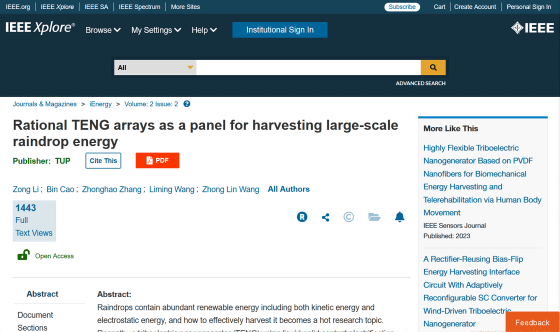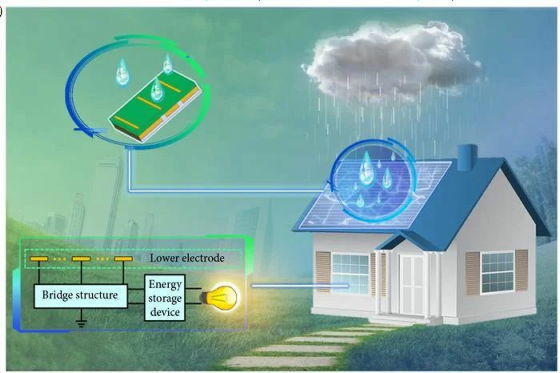A breakthrough to use rain energy for power generation will be announced, will a ``rain panel'' that is not a solar panel appear?

In recent years, attempts to use natural renewable energy such as sunlight and wind power for power generation are progressing, and some people have thought that 'rain that falls from the sky can also be used for power generation.' there should be In fact, although raindrop power generation using rain has been devised for some time, it is said that scaling up was hindered by technical problems, but a new research team in China has achieved a breakthrough in raindrop power generation. Announced.
Rational TENG arrays as a panel for harvesting large-scale raindrop energy | TUP Journals & Magazine | IEEE Xplore

Collecting energy from raindrops using solar | EurekAlert!
https://www.eurekalert.org/news-releases/996074
Forget Solar Panels. Here Come Rain Panels - The Debrief
https://thedebrief.org/forget-solar-panels-here-come-rain-panels/
Raindrops falling from the sky contain kinetic energy and electrostatic energy due to falling from high clouds, and it is possible to generate electricity using these energies. In fact, in the past, attempts have been made to make an umbrella emit light by using the vibrational energy of raindrops colliding with a piezoelectric film called polyvinylidene fluoride (PVDF) .
Peace of mind even on rainy nights, a umbrella that shines with rain power generation - GIGAZINE

However, there are technical hurdles in attempting to efficiently collect energy from falling raindrops, and large-scale raindrop power generation has not been realized. In recent years, droplet-based TENG (D-TENG ) using a triboelectric nanogenerator (TENG) that converts mechanical energy into electrical energy through a combination of triboelectrification and electrostatic induction has demonstrated We have successfully collected measurable power.
However, although D-TENG can achieve instantaneous high output, it is still difficult to continuously supply power to megawatt-level electronic devices with one unit. In addition, solar panels achieve high output by combining many solar cells into a single circuit, but when multiple D-TENG are combined, unintended capacitive coupling ( capacitive coupling) occurs, and the power loss between cells increases, resulting in a decrease in the overall output.
Therefore, a research team led by Professor Zong Li of the Shenzhen Institute of International Studies, Tsinghua University in Shenzhen, China, is equipped with an array bottom electrode and a bridge circulation structure to make each power generation unit independent of each other while eliminating the effects of capacitive coupling. I devised a 'bridge array generator' like this.
In D-TENG, when rain falls on the panel surface, the raindrops are positively charged and the panel surface is negatively charged, but the charge on the panel surface gradually dissipates, leading to energy loss. The bridge array generator is said to have made it possible to efficiently collect the energy of raindrops by adding an array lower electrode and a bridge circulation structure to this.

When the research team conducted tests on bridge array generators with different structures, the peak output of the bridge array generator was about five times higher than that of conventional raindrop panels of the same size, reaching 200W per square meter. It is said that he did.
“Droplet TENG can deliver high power instantaneously, but it is still difficult for a single unit to continuously power megawatt-level electronics,” Li said. Simultaneous use is very important.” “Inspired by the design of solar panels that connect multiple photovoltaic units in parallel to supply electricity, we developed a simple and effective method for raindrop energy harvesting. I will make a proposal,' he said.

Related Posts:
in Science, Posted by log1h_ik







